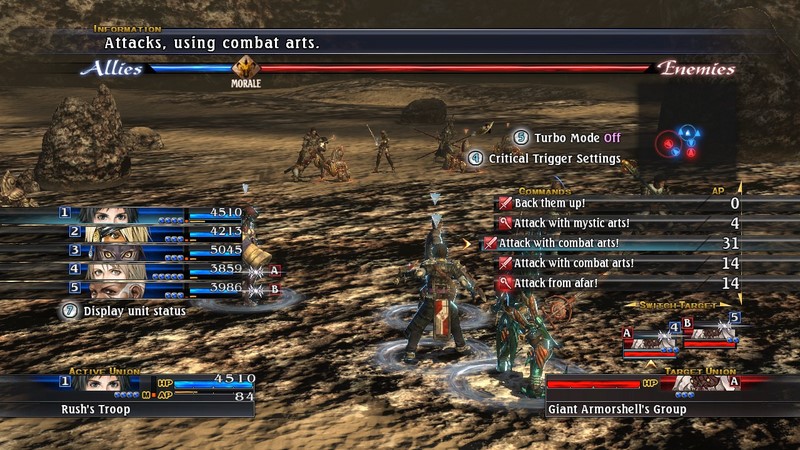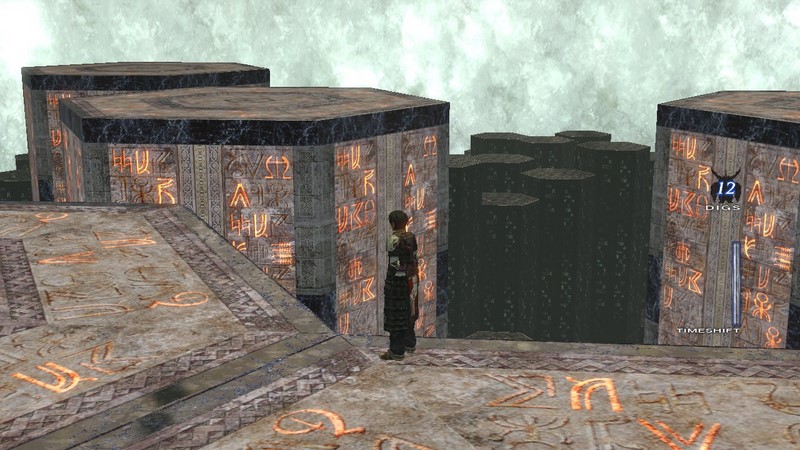I’m still not entirely sure how I feel about The Last Remnant. On the one hand, its Akitoshi Kawazu pedigree shines through, with an incredibly nuanced battle system that never fully makes up for its terrible plot. On the other hand, that battle system is really very good and worth playing the game for on its own, it’s just that the plot was made even worse – seemingly deliberately – to balance things out.
Kawazu has a long history of working on the SaGa games, and it is entirely reasonable to call TLR a stealth entry in the series, since it has many of the hallmarks. Aside from standard battle system/plot dichotomy, there’s a wonderfully imaginative world that very little is actually done with, entertaining side characters that never really break into the third dimension, incredibly good music that has only bits and pieces of substance to go with, and enough sidequests to deliberately avoid the main story for hour on end. Atmosphere is fed in small spoonfuls for completing hour-long quests, while stat increases are passed out like candy on Halloween after every single battle.
After all of that negative talk about both SaGa and this game, I still really enjoyed much of my time spent on it. Of that enjoyed time, perhaps 10% was actually plot – the parts that are most enjoyable, of course, are totally independent of the reckless, clueless main character (appropriately named Rush) and focus instead on Marquis David of Athlum and his subordinates, as they struggle to deal with the political realities of the world. The other 90% was spent chasing various rabbits cleverly disguised as sidequests; find this dungeon somewhere on the world map, often via dungeons, and then explore it until you fight a boss. Along the way you’ll gather materials, adjust unit layouts to deal with new enemies, acquire various items, find optional bosses and so on. At least half of the dungeons are fully optional and many of them can be accessed not long into the game – although if you spend a long time leveling up your initial characters, you’ll run into difficulty when you get new ones that are either more relevant or are better long-term.

The battle system includes lots of bars and numbers. It will make you feel important.
The battle system, of course, is the best part of the game. It’s an unusual approach to making the game feel larger-scale; rather than individual characters fighting, you organize people into groups (Unions) with combined health, give them high-level commands (Attack with Combat Arts!) and point them at the enemy. They’ll do their best to follow your commands, but they might get intercepted by an enemy unit and have to readjust. Other mechanics, such as deadlocking (once two units are engaged, neither can move to attack others until one of them disengages deliberately), long-range attacks, formations, a morale system, and so on lend more credence to this large-scale approach. In the end, the result is much the same as a standard RPG; if you win, you get rewards and occasionally stat increases to individual units. Since this is, of course, a modern RPG, and casting spells or using items between battles is simply barbaric, TLR restores all health between battles. The only penalty for losing a unit entirely is that nobody in that group will improve for that battle.
Unfortunately, The Last Remnant went the standard Kawazu route for difficulty balance and made enemies scale with a “battle level” which measures your progress. This means that grinding will often not help you overcome a particularly hard boss. In the PC version, at least, it rarely hurts you – but it’s not like it will help you move through the game faster if you spend 10 hours sidequesting before continuing with your plot. Many optional bosses will be incredibly difficult until you reach a certain point – and even then, will require very specific strategies to overcome. Storyline bosses, meanwhile, will still slaughter any unit sent in to deadlock them, which makes even storyline boss battles an endless loop of resurrecting your dead unions while putting up enough of a wall to hold the lines. This constant life on the edge during battles makes the victory in the end sweeter, but it also makes it feel totally ridiculous and somewhat random.

One of the later dungeons in TLR. Lots of variety in dungeons, which is good since that’s where most of your time will be spent.
Luckily for the PC player, The Last Remnant is not only available on PC, it is by far the better version of the game. It has good gamepad support, adjustable graphics, dual-language voice options, and the most important part – a turbo mode for battles, which makes them easily three times faster. Although a casual PC gamer may not have the specs to run the game, anyone trying to keep up – even on less graphically intensive genres – will probably have a machine capable of running it. Still better, since it’s on Steam, it can be bought on the cheap at least twice a year – and still seems to be fairly popular.
Since I make a habit of doing a quick plot overview pretty much all the time, I may as well give TLR the benefit of the doubt – someone may be intrigued enough by my summary to consider the game. Rush is a guy living on an island with his (adoptive? they’re vague) sister. She gets kidnapped by a guy with a flying Remnant (oh yeah, Remnants are ancient, mysterious tools that can do many things and are bound to people). His parents are busy on the continent doing Important Remnant Research and totally impossible to contact, so Rush runs off on his own to find his sister. He runs into the middle of a battlefield where David Athlum is beating down some monsters. Upon introduction, David recognizes his last name and decides to help him out for no adequately explained reason. Much of the rest of the game is spent taking on increasingly unrealistic challenges, coupled with revelations about who wields true political power in a world filled with destructive and/or beneficial ancient tools that nobody really understands. Only in the end, of course, does the title become relevant. There is a Remnant, and it is The Last One. The end. The entire game is full of people with poorly explained or simply unexplained reasons for the decisions they make. There are a couple of cool cutscenes, but there is nothing redeemable in the plot.
To be honest, though, it’s not like the plot is that bad. It is no Final Fantasy, filled to the brim with melodrama and with endlessly intertwining backstories. Nor is it a Dragon Quest, filled with standard vignettes to fill the space between dungeons. There is plot, and while it is not good, neither is it unbearable. It merely is, and if the player can simply go with the flow and let it wash over them, it can be fully ignored and the battle and item customization systems enjoyed for their own sake.

